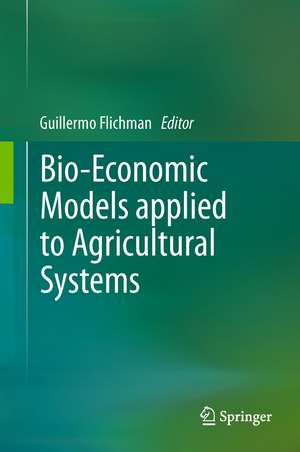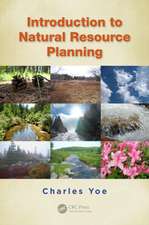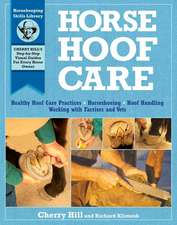Bio-Economic Models applied to Agricultural Systems
Editat de Guillermo Flichmanen Limba Engleză Hardback – 10 sep 2011
| Toate formatele și edițiile | Preț | Express |
|---|---|---|
| Paperback (1) | 637.28 lei 6-8 săpt. | |
| SPRINGER NETHERLANDS – 21 noi 2014 | 637.28 lei 6-8 săpt. | |
| Hardback (1) | 562.85 lei 38-44 zile | |
| SPRINGER NETHERLANDS – 10 sep 2011 | 562.85 lei 38-44 zile |
Preț: 562.85 lei
Preț vechi: 703.56 lei
-20% Nou
Puncte Express: 844
Preț estimativ în valută:
107.70€ • 112.75$ • 89.12£
107.70€ • 112.75$ • 89.12£
Carte tipărită la comandă
Livrare economică 01-07 aprilie
Preluare comenzi: 021 569.72.76
Specificații
ISBN-13: 9789400719019
ISBN-10: 9400719019
Pagini: 260
Ilustrații: XII, 220 p.
Dimensiuni: 155 x 235 x 15 mm
Greutate: 0.45 kg
Ediția:2012
Editura: SPRINGER NETHERLANDS
Colecția Springer
Locul publicării:Dordrecht, Netherlands
ISBN-10: 9400719019
Pagini: 260
Ilustrații: XII, 220 p.
Dimensiuni: 155 x 235 x 15 mm
Greutate: 0.45 kg
Ediția:2012
Editura: SPRINGER NETHERLANDS
Colecția Springer
Locul publicării:Dordrecht, Netherlands
Public țintă
GraduateCuprins
Acknowledgments.- Preface.- Part I.- Ch. 1. Modelling the relationship between agriculture and the environment using bio-economic models: some conceptual issues.- Ch. 2. Bio physical models as detailed engineering production functions.- Ch. 3. Dynamic optimisation problems: Different resolution methods regarding agriculture and natural resource economics.- Ch. 4. Biophysical models for cropping system simulation.- Part II.- Ch. 5. Incorporating yield information from a biogeochemical model into an agricultural production model to infer adoption of a new bioenergy crop.- Ch. 6. Agri-environmental nitrogen indicators for EU27.- Ch. 7. Modelling Nitrogen balance for a regional scale livestock-pasture system as a discussion support tool.- Ch. 8. Using a Bio-economic Model to Assess the Cost-effectiveness of Measures against Nitrogen Pollution.- Ch. 9. On-farm weather risk management in suckler cow farms: A recursive discrete stochastic programming approach.- Ch. 10. Integrated bio-economic farm modeling for biodiversity assessment at landscape level.- Conclusions.
Recenzii
From the reviews:
“This book is a collection of articles by European and American researchers on the use of bio-economic models applied to agricultural systems. The objective is ambitious: ‘providing the state of the art’ regarding bio-economic models. … It will be indispensable for researchers in the field of mathematical programming applied to the agricultural sector.” (Filippo Arfini, European Review of Agricultural Economics, Vol. 39 (5), December, 2012)
“This book is a collection of articles by European and American researchers on the use of bio-economic models applied to agricultural systems. The objective is ambitious: ‘providing the state of the art’ regarding bio-economic models. … It will be indispensable for researchers in the field of mathematical programming applied to the agricultural sector.” (Filippo Arfini, European Review of Agricultural Economics, Vol. 39 (5), December, 2012)
Textul de pe ultima copertă
The bio-economic modeling approach presented in this book is a result of two distinct developments: by one side, the improvement of bio-physical simulation models applied to agricultural systems and by the other, the evolution of agricultural policies demanding a kind of assessment that conventional economic models are not able to provide. Some economists began to realize that biophysical models could be considered as detailed engineering production functions, allowing to represent in a consistent manner the joint products of agricultural activities. The perspectives that this vision provides allow dealing with environmental and natural resources issues with an economic perspective in an efficient manner. Representing environmental impacts of agricultural activities measured in physical units allows performing cost-efficiency calculations of alternative policies, potentially able to attain specified policy targets. This capability permitted in recent years the development of applied research related with institutional demands from national and international public institutions. But this approach requires a multidisciplinary approach, with positive and negative effects. The positive one is, both for economists and biophysical scientists, to enlarge their vision of the world. The negative effects are the greater difficulty to get recognized in their specific discipline, the obstacles to obtain the necessary information for properly use these models, and the longer time to perform the research activity. The “productivity” for producing papers is lower for economists applying this approach compared with economists applying econometric methods, using available published data. In spite of these negative effects, as the demands from the real world for the assessment these models areable to provide is increasing, it is quite possible that there is a future for bio-economic models applied to agricultural systems. The challenges of Climate Change, the increase care for the preservation of natural resources and the environment will require further developments of this kind of approach.
Caracteristici
Bio-Economic models are adequate tools for assessing agricultural and environmental policies The methods described in this book are appropriate to analyse impacts of Climate Change and mitigation policies Includes different applications at various scales, farm, small region, big region Provides the “state of the arts” concerning bio-economic modelling dealing with agricultural systems








